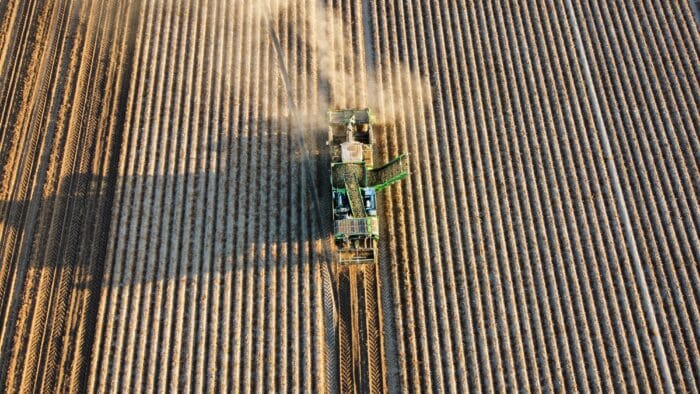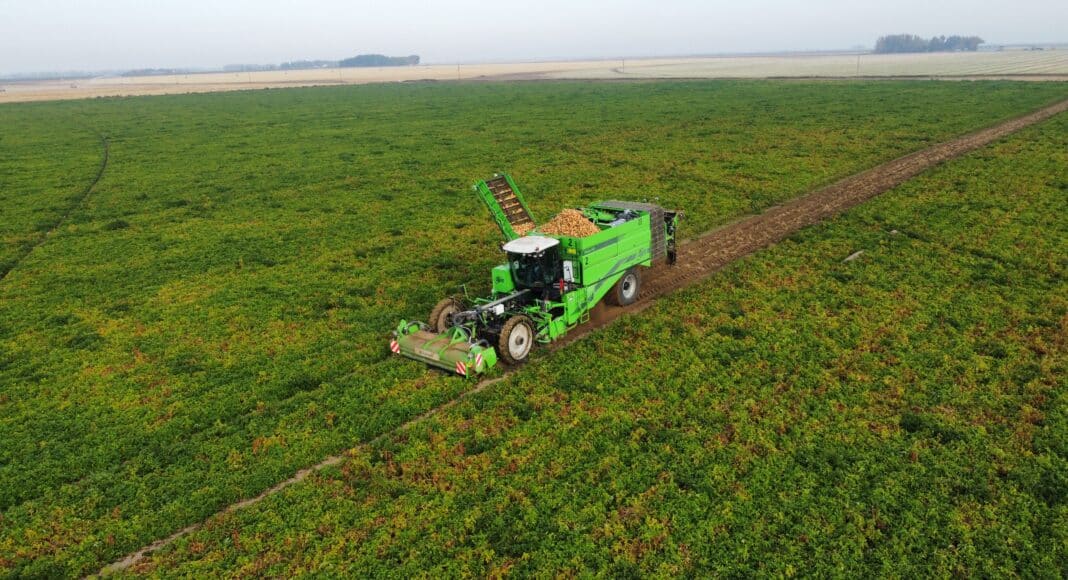IN 1849, a man by the name of Pieter Vansteenkiste founded a forge in Roeselare, Belgium, where he and his family manufactured agricultural and horticulture tools like shovels and garden hoes.
For 175 years, that same company, based out of that same town and still wholly family-owned and operated, has serviced the needs of farmers — especially (and now exclusively) potato farmers. Belgian and Dutch farmers have trusted AVR for decades as their go-to source of potato harvesters, which is why it was Belgian and Dutch immigrants to Canada who introduced AVR to this side of the Atlantic. Over the past 20 years, the benefits of AVR machines have spread via word of mouth across Canadian potato fields. Today, AVR is a top harvester option. If you haven’t yet had a look at AVR’s Puma 4.0 self-propelled harvester, here’s why you should check it out.
What’s new in the Puma 4.0
AVR manufactures various pieces of potato-specific equipment, from field operations to storage equipment in the bins. The company is most well-known, especially in Canada, for its light but powerful, highly efficient potato harvesters. Featuring the gentlest handling in the business, AVR’s Puma line of harvesters are particularly popular in high-value potato applications where quality is more important that capacity. However, its newest Pumas — the Puma 4.0 — is gaining attention among processing producers as well.
“While it doesn’t feature the capacity of some of the highest volume processing-specific machines on the market, the Puma 4.0’s efficiency in fuel consumption, weight, consumables, spare parts, ease of service and more make it an option worth considering,” says Mathieu Trifin, AVR’s Business Development Manager.
The Puma 4.0 delivers several key benefits:
First, it’s the lightest self-propelled harvester on the market.
“That’s important because soil compaction is a big issue. Large capacity harvesters are very, very strong, but they are very heavy as well. The Puma 4.0 is significantly lighter than its North American competitors, but it is also strong for its size,” Trifin says.
That lightness translates to notable efficiency: at about 30L/hr diesel consumption, the Puma 4.0’s fuel efficiency is dramatically higher than its competitors.
In terms of potato handling, the Puma 4.0 is specially designed to take optimal care of high-value tubers. Pressure sensors and other components adjust automatically to meet the changing flow of harvested potatoes. Every web’s speed is adjustable and independent.
“We’re making it easier and easier for someone to operate the machine who maybe doesn’t have as much experience or skill,” Trifin says.
Yield Data is Just the Start
The biggest change in AVR’s innovation in the last handful of years is based on data: data collection, data storage and smart data-based decision making. AVR leads harvesting equipment manufacturers in data-collecting capacity and effective data usage.
While tracking yield in above ground harvested crops like grains and oilseeds is old news, yield data collection in potatoes has traditionally been very difficult due to the challenge of separating out soil and green matter at the harvester. That’s changed in the last handful of years, thanks to innovation from AVR. For the past four years, AVR’s newest generations of harvesters have effectively tracked yield.
“Next to the potato crop in storage, we want to bring quality data: all the details that answer exactly what the farmer is harvesting and storing. We developed this through talking to farmers and processing companies about what innovation and information they need on our potato harvesters so they can make better decisions at harvest, through storage, at shipping and into the next growing season,” Trifin says.
Yield data is just the start. The next major frontier in data collection is tuber sizing right at the harvester. In 2023, AVR piloted a new camera-based AI technology in its newest line of harvesters that assesses and sorts potatoes by size as they come out of the ground.
This is critical data for both the grower and the buyer. Imagine, for example, a company that divides potatoes into small, medium and large categories for packaging and sale. Knowing exactly what is coming out of the ground means a grower can best categorize and prepare the crop for sale according to those product categories. Too, the buyer can use the data to adjust to best fill bags: if data shows that season’s crop tends just a little larger, the packager might adjust the categories’ size divisions to accommodate and optimize that crop.

“We started in 2020 focusing on general yield data. Now more and more it’s about identification of the potatoes. It’s a very big and important innovation,” Trifin says. “The marketplace is very, very excited about it. This is definitely the future for crop management.”
Enhanced harvest data tracking offers another key benefit: traceability.
“Being able to say, ‘The potatoes in this box in this storage come from that part of the field’ is huge,” he says.
Even if a farmer doesn’t analyze the data right as it comes out of the ground, they can go back some months later with the data in hand to develop a yield map of the field, allowing them to adjust agronomy and management more precisely in future years.
Trifin says AVR has one Canadian customer, for example, who uses yield maps to make fertilizing decisions based on knowing one part of the field has more potential than another part of the field. Another farmer uses that harvest data at planting to adjust seed spacing based on that portion of the field’s productivity.
“It’s coming. The new generation is excited about managing with data,” he says.
Uniquely Suited to Canadian Production
Though designed and built in Europe, AVR’s equipment suits Canadian production. AVR engineers have spent significant time in Canada talking to farmers, then made multiple adjustments based on that feedback.
Compared to its competitors, AVR boasts an engine that runs cooler, so doesn’t overheat in hot and dry conditions. It also offers auto-steer: a big benefit in dusty fields where manual guidance is sometimes nearly impossible. At least as importantly, this is a small machine with the power Canadian farmers need.
“In Canada, the [varieties] have a lot tougher green vines. So, it can be challenging for a light harvester to get through. We developed options to make it easier to harvest those kinds of potatoes,” Trifin says. “The engine is over-dimensioned. We use 50-60 per cent capacity, so there’s low RPM. That’s also why the fuel consumption is lower, but it’s got that power.”
Serving Canada’s Potato Producers
AVR has several active dealers in Canada. Tom Janssen, CEO at Metric Farm Solutions in Edmonton, serves the western Canadian market. He was first introduced to the Puma line of harvesters — and became convinced of their benefits — while working on a seed potato farm. Today, he says it’s an honour to be an AVR dealer.
“I always enjoyed working with [Pumas] because of their simplicity. They contain a lot of technology but they’re not unnecessarily complicated, so it makes them easy to work with and easy to work on,” he says. “Fuel economy is another big thing: the next closest [competitor] is probably 20 per cent higher in fuel use. That really sets it apart in my mind.”
Mathieu Ricard, president and owner at Riego in Lavaltrie, Quebec, represents AVR for Quebec and the Maritimes. He says his reason for choosing AVR is its customer-first perspective.
“It’s about selling the product that the customer really needs, not just selling the product that I’m selling. In Eastern Canada, farmers are looking for smaller but really efficient equipment: that’s what we offer. And we have big quality but a smaller name, so our price is lower.”
“As for me, I’m proud to be part of AVR because I believe it truly has farmers’ best interests in mind,” says Trifin. “Our oldest AVR Puma operating in Canadian potato fields is from 2006. It successfully helped harvest in 2023, and I expect it’ll be out in the fields again in 2024. That’s Puma: leadership and innovation, but longevity too.”
AVR: Passion. Power. Potatoes.











